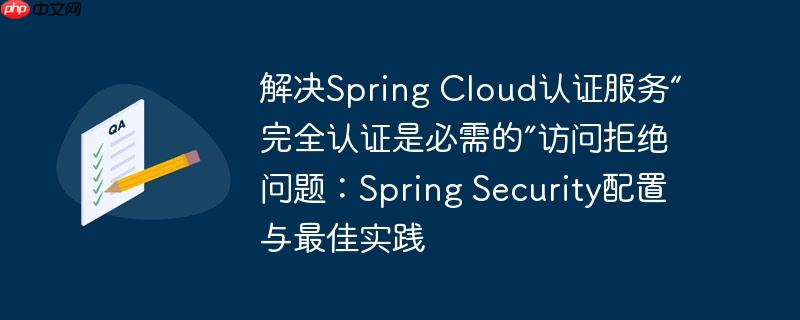
在基于spring cloud构建微服务应用时,认证服务(auth service)是核心组件之一,负责用户的注册、登录和令牌管理。然而,开发者常常会遇到一个常见的安全配置问题:当尝试访问如用户注册(/authenticate/signup)这类本应公开的端点时,却收到“full authentication is required to access this resource”的错误信息。这表明spring security默认拦截了这些请求,要求进行完全认证,而这些端点本身就是用于获取认证的。
当通过API Gateway转发请求时,同样的问题可能导致API Gateway报告“Could not send request”的错误,这通常是由于后端认证服务拒绝了请求而导致的。本教程将详细解析这一问题,并提供清晰的解决方案和最佳实践。
Spring Security默认采取“安全至上”的原则,即如果没有明确配置,所有传入的HTTP请求都将被视为需要认证。对于一个使用JWT(JSON Web Token)和刷新令牌机制的认证服务来说,用户注册、登录以及刷新令牌等操作是用户获取初始认证或更新认证的关键步骤。这些端点在用户尚未认证的情况下就必须能够被访问,否则用户将无法进行任何操作。
因此,当Spring Security没有将这些入口点标记为公共可访问时,它会拦截请求并抛出AccessDeniedException,最终表现为“Full authentication is required to access this resource”错误。API Gateway作为流量入口,如果其背后的认证服务拒绝了请求,它自然也无法成功发送或处理请求,从而向上层抛出“Could not send request”的错误。
解决此问题的关键在于正确配置Spring Security的HttpSecurity,明确指定哪些URL路径可以无需认证即可访问。以下是针对旧版Spring Security配置(基于WebSecurityConfigurerAdapter)的示例:
import org.springframework.security.config.annotation.web.builders.HttpSecurity;
import org.springframework.security.config.annotation.web.configuration.EnableWebSecurity;
import org.springframework.security.config.annotation.web.configuration.WebSecurityConfigurerAdapter;
@EnableWebSecurity
public class WebSecurityConfig extends WebSecurityConfigurerAdapter {
@Override
protected void configure(HttpSecurity http) throws Exception {
http
.csrf().disable() // 通常在无状态API中禁用CSRF
.authorizeRequests(auth -> {
// 允许特定认证端点无需认证即可访问
auth.antMatchers("/authenticate/signup", "/authenticate/login", "/authenticate/refreshtoken").permitAll();
// 其他所有请求都需要认证
auth.anyRequest().authenticated();
})
// 或者,更简洁的写法(Spring Security 5.x 兼容)
// .authorizeRequests()
// .antMatchers("/authenticate/signup", "/authenticate/login", "/authenticate/refreshtoken").permitAll()
// .anyRequest().authenticated()
// .and()
// ... 其他配置,如session管理、异常处理等
;
}
}代码解释:
通过以上配置,Spring Security将不再拦截对注册、登录和刷新令牌端点的请求,从而允许用户顺利进行这些操作。一旦认证服务正常工作,API Gateway的“Could not send request”问题也将随之解决,因为它现在能够成功地将请求转发并接收到有效的响应。
值得注意的是,从Spring Security 5.7.0-M2版本开始,WebSecurityConfigurerAdapter已被弃用。官方推荐使用基于组件的配置方式,即通过定义SecurityFilterChain类型的Bean来配置安全过滤器链。
虽然上述解决方案仍然有效,但为了遵循最新的最佳实践,建议将安全配置迁移到新的方式。新方式的核心思想是:
以下是概念性的新版配置示例(请参考官方文档获取完整细节):
import org.springframework.context.annotation.Bean;
import org.springframework.context.annotation.Configuration;
import org.springframework.security.config.annotation.web.builders.HttpSecurity;
import org.springframework.security.web.SecurityFilterChain;
@Configuration
public class SecurityConfig {
@Bean
public SecurityFilterChain filterChain(HttpSecurity http) throws Exception {
http
.csrf(csrf -> csrf.disable()) // 使用Lambda表达式配置CSRF
.authorizeHttpRequests(authz -> authz
// 允许特定认证端点无需认证即可访问
.requestMatchers("/authenticate/signup", "/authenticate/login", "/authenticate/refreshtoken").permitAll()
// 其他所有请求都需要认证
.anyRequest().authenticated()
)
// ... 其他配置
;
return http.build();
}
}这种新方式更加灵活和模块化,是未来Spring Security配置的推荐方向。有关更多详细信息和迁移指南,请参阅Spring官方博客文章:Spring Security without the WebSecurityConfigurerAdapter。
“Full authentication is required to access this resource”错误在Spring Cloud认证服务中是一个常见但易于解决的问题。通过将认证相关的公共端点(如注册、登录、刷新令牌)明确配置为permitAll(),可以确保这些关键入口点能够被未经认证的用户访问。同时,了解并采纳Spring Security的最新配置模式,将有助于构建更现代化、更易于维护的安全架构。始终牢记安全规则的顺序和permitAll()的谨慎使用,是确保微服务应用安全性的重要原则。
以上就是解决Spring Cloud认证服务“完全认证是必需的”访问拒绝问题:Spring Security配置与最佳实践的详细内容,更多请关注php中文网其它相关文章!

每个人都需要一台速度更快、更稳定的 PC。随着时间的推移,垃圾文件、旧注册表数据和不必要的后台进程会占用资源并降低性能。幸运的是,许多工具可以让 Windows 保持平稳运行。

Copyright 2014-2025 https://www.php.cn/ All Rights Reserved | php.cn | 湘ICP备2023035733号